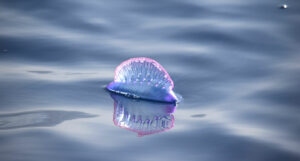
If you want to get in touch with nature, Tenerife is the best place and Whale Watch Tenerife is the adventure for you!
In fact during our whale watching tours in Tenerife we have the opportunity to observe an incredible amount of wild life, whales, dolphins , sea birds, including the beautiful Portuguese Man o’War.
The Man o’ War (Physalia physalis) also known as a Bluebottle, is often called a jellyfish, but is actually a species of siphonophore, a colony of organisms, polyp, called zooids working together as one.
The man-of-war is composed with four separate parts-polyps specialized in different functions:
Floating
The pneumatophore, or bladder. Resembling an 18th-century Portuguese warship with a big sail, the Man o’ War is easily recognized by its balloon-like float, which may be blue, violet, or pink and rises up to six inches above the waterline.
Capturing prey and feeding
Lurking below the float are long strands of tentacles that grow to an average of 10 meters and may extend by as much as 30 meters. The tentacles contain stinging called nematocysts, microscopic capsules loaded with coiled, barbed tubes that deliver venom capable of paralyzing and killing the prey. They are carnivores and some of their common preys are small fish, fish larvae, squid, shrimp, and more. However, fish make up the vast majority of their diet. The muscles in the tentacles draw prey up to a polyp containing the gastro zooids or digestive organisms.
Reproduction:
Each individual Portuguese Man o’ War is either a male or a female, and they reproduce sexually via a method known as broadcast spawning. Large groups of Portuguese Man o’ War come together, where females release their eggs and males release their sperm into the water column, all at the same time.
The result then, is that each larvae will go through asexual budding to produce a new Man-of-War colony.

Habitat and distribution
They can be found in tropical and subtropical waters floating in groups of more than 1,000. They can not propulsion themselves, they can either drift on the currents or catch the wind with their pneumatophores (their sail). To avoid threats on the surface, they can deflate their air bags and briefly submerge. One of their main predators are sea turtles.
Be careful!
To avoid being stung, never touch these animals with bare skin and DO NOT ENTER THE WATER IF THEY ARE PRESENT. For humans the sting is very painful and can cause serious effects, including fever, shock, and interference with heart and lung action.
Also take care if you see them washed on the beach, because the tentacles can sting even if the colony is dead.
 Booking
Booking








